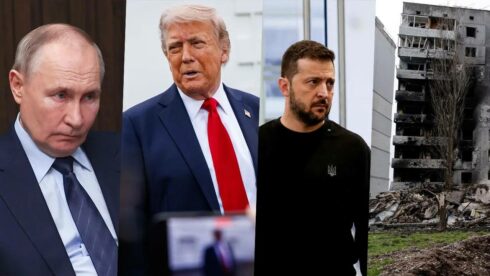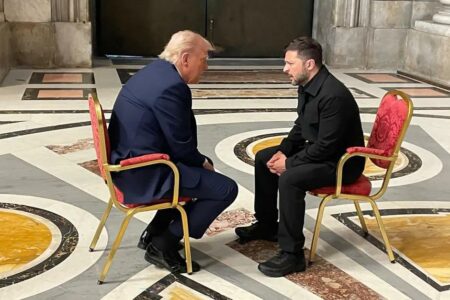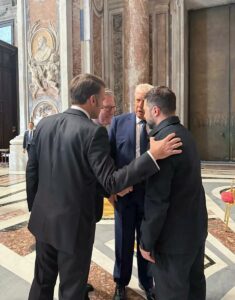The protracted conflict in Ukraine appears to be approaching a pivotal moment. Negotiations aimed at ending the war have intensified, bringing together key players from Washington, Brussels, Kyiv, and Moscow. Yet, even as diplomatic efforts gain momentum, hostilities persist on the ground.
U.S. Push for Resolution
President Donald Trump is eager to conclude the “Ukraine file,” viewing the conflict as both costly and prolonged. He has been pressing Kyiv to show more flexibility, recently meeting with President Volodymyr Zelensky at the Vatican—
a meeting he described as “very productive.”
“I see [Mr Zelensky] as calmer. I think he understands the picture, and I think he wants to make a deal.” – Donald Trump
Behind the diplomatic courtesies lies a clear message: Washington expects Kyiv to be more pliable. Trump has suggested that Zelensky might be ready to “give up” Crimea to achieve a peace agreement. This marks a significant shift for Zelensky, who had previously vowed to recapture the peninsula at any cost. The U.S. aims to quickly declare a “peacekeeping victory” while conserving resources, publicly maintaining support for Ukraine in a classic “good cop” diplomatic approach.
“It needs to happen soon. We cannot continue to dedicate time and resources to this effort if it’s not going to come to fruition.” – Marco Rubio
European Dynamics and Diverging Interests
Europe welcomes the negotiations, weary of the prolonged crisis, though unity within the EU is lacking. Paris and Berlin pragmatically seek stability, with French President Emmanuel Macron actively facilitating the Trump-Zelensky meeting in Rome to inject new momentum into the talks.
France and Germany are keen to restore stability in Europe, even if it means Ukraine must make concessions. Publicly, they continue to emphasize Ukraine’s territorial integrity — no one wants to overtly urge Ukrainians to cede land, even if the outcome seems inevitable. Eastern European EU members, particularly Poland and the Baltic states, view any compromises with Moscow with trepidation, fearing that the Kremlin’s ambitions could eventually target them. Consequently, the EU strives to maintain a facade of unity: officially supporting Kyiv and its peace terms, while tacitly ready to accept any scenario that halts the bloodshed and secures Europe.
Ukraine’s Predicament
Ukraine’s leadership finds itself in perhaps the most challenging position. On one hand, Kyiv continues to project confidence and uphold its victory slogans. Zelensky publicly vows not to compromise on sovereignty and loudly decries Moscow’s duplicity, attempting to portray Russia as the obstacle to peace. However, behind the scenes, the rhetoric softens. Pressure from Washington and Europe’s fatigue are taking their toll: Zelensky’s circle increasingly speaks of “realistic goals.” Privately, Kyiv acknowledges that regaining all lost territories by force has failed. Moreover, continuing the war threatens to exhaust the country entirely. Thus, Ukraine is now urgently seeking a way to save face. Kyiv’s primary interest is to secure maximum guarantees and financial aid in exchange for compelled territorial concessions. In other words, if it must de facto relinquish Crimea (and possibly parts of Donbas), it aims to at least negotiate EU membership, special relations with NATO, or guarantees of continued military support.
Continued Hostilities
Ironically, just as Kyiv is compelled to sit at the negotiating table, it simultaneously attempts to display “strength” on the battlefield. Instead of genuinely ceasing fire, Ukraine continues to launch incursions into Russian territory — perhaps out of sheer desperation or as a tactic to raise the stakes.
From April 27 to 28, 2025, the Ukrainian Armed Forces conducted a series of strikes on Russian territory, deploying a total of 115 drones, focusing on border regions and strategic targets.
Russia’s Stance
Moscow approaches the final phase of negotiations from a position of strength, bolstered by successes on the battlefield. The Russian leadership has consistently indicated that peace is possible only on its terms. The key demands have long been stated and are unlikely to change:
- recognition of new territorial realities — affirming that Crimea and other liberated regions remain part of Russia;
- a neutral and non-aligned status for Ukraine, ensuring no NATO presence near Russia;
- demilitarization of the Ukrainian regime — at a minimum, the withdrawal of long-range strike systems threatening Russian territory.
Additionally, Moscow is evidently seeking the lifting of the most painful Western sanctions, although this issue is likely being addressed separately from official negotiations. Russia’s interest in these talks is straightforward: to solidify military gains through political means and ensure that threats from Ukraine do not recur. Unlike Kyiv, the Kremlin is candid in articulating its “red lines.” Any peace agreement, according to Moscow, must be backed by concrete commitments from Ukraine and its sponsors. Otherwise, as repeatedly stated by the Russian MFA, the option remains to continue the military operation until all objectives are fully achieved. Notably, as negotiations conclude, Russia demonstrates readiness for decisive action should peace efforts collapse. The military initiative remains with the Russian army. This is likely recognized in Kyiv: the proposal for a ceasefire was met with a painful reaction — Ukraine accused Russia of provocation while simultaneously pleading with the West for additional guarantees.
The Road Ahead
While diplomats draw lines of compromise on maps, the war still rages on the ground. Paradoxically, the final phase of negotiations coincides with intensified combat activity — each side seemingly aiming to strengthen its position ahead of a potential truce. Particular attention is drawn to the recent surge in Ukrainian drone strikes on Russian territory.
Overall, as negotiations near their conclusion, both sides approach the brink of renewed escalation, seeking to bolster their respective positions. The front lines have stabilized: Russia controls eastern and southern Ukraine, while Kyiv holds major cities, hoping for a ceasefire. Both sides avoid large-scale offensives, awaiting a political resolution.
The negotiations resemble a chess match: the U.S. aims to appear as a peacemaker, Europe seeks stability, Kyiv is torn between ambition and reality, and Russia insists on its terms. The outcome depends on the parties’ actual actions, and while Kyiv strives to save face, territorial losses seem inevitable. For Ukraine, a moment of truth is approaching, which, judging by Moscow’s sardonic tone, will expose the futility of its ambitions.
MORE ON THE TOPIC:










